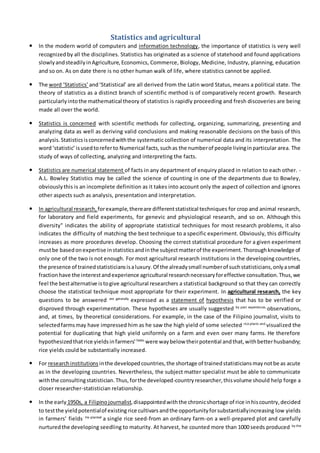
Statistics and agricultural research techniques
- 1. Statistics and agricultural In the modern world of computers and information technology, the importance of statistics is very well recognized by all the disciplines. Statistics has originated as a science of statehood and found applications slowlyandsteadilyinAgriculture,Economics, Commerce, Biology, Medicine, Industry, planning, education and so on. As on date there is no other human walk of life, where statistics cannot be applied. The word ‘Statistics’ and‘Statistical’ are all derived from the Latin word Status, means a political state. The theory of statistics as a distinct branch of scientific method is of comparatively recent growth. Research particularlyintothe mathematical theory of statistics is rapidly proceeding and fresh discoveries are being made all over the world. Statistics is concerned with scientific methods for collecting, organizing, summarizing, presenting and analyzing data as well as deriving valid conclusions and making reasonable decisions on the basis of this analysis.Statisticsisconcernedwiththe systematic collection of numerical data and its interpretation. The word‘statistic’ isusedtoreferto Numerical facts,suchas the numberof people livinginparticular area. The study of ways of collecting, analyzing and interpreting the facts. Statistics are numerical statement of facts in any department of enquiry placed in relation to each other. - A.L. Bowley Statistics may be called the science of counting in one of the departments due to Bowley, obviouslythis is an incomplete definition as it takes into account only the aspect of collection and ignores other aspects such as analysis, presentation and interpretation. In agricultural research, forexample,thereare differentstatistical techniques for crop and animal research, for laboratory and field experiments, for genevic and physiological research, and so on. Although this diversity" indicates the ability of appropriate statistical techniques for most research problems, it also indicates the difficulty of matching the best technique to a specific experiment. Obviously, this difficulty increases as more procedures develop. Choosing the correct statistical procedure for a given experiment mustbe basedonexpertise instatisticsandinthe subjectmatterof the experiment.Thoroughknowledge of only one of the two is not enough. For most agricultural research institutions in the developing countries, the presence of trainedstatisticiansisaluxury.Of the alreadysmall numberof suchstatisticians,onlyasmall fractionhave the interestandexperience agricultural researchnecessaryforeffective consultation.Thus,we feel the bestalternative istogive agricultural researchers a statistical background so that they can correctly choose the statistical technique most appropriate for their experiment. In agricultural research, the key questions to be answered are generally expressed as a statement of hypothesis that has to be verified or disproved through experimentation. These hypotheses are usually suggested by past experiences, observations, and, at times, by theoretical considerations. For example, in the case of the Filipino journalist, visits to selectedfarmsmay have impressed him as he saw the high yield of some selected rice plants and visualized the potential for duplicating that high yield uniformly on a farm and even over many farms. He therefore hypothesizedthatrice yieldsinfarmers' fields were waybelow theirpotential andthat,withbetterhusbandry; rice yields could be substantially increased. For researchinstitutions inthe developedcountries,the shortage of trainedstatisticiansmaynotbe as acute as in the developing countries. Nevertheless, the subject matter specialist must be able to communicate withthe consultingstatistician.Thus,forthe developed-countryresearcher,thisvolume should help forge a closer researcher-statistician relationship. In the early 1950s, a Filipinojournalist,disappointedwiththe chronicshortage of rice inhiscountry,decided to testthe yieldpotentialof existing rice cultivars andthe opportunityforsubstantiallyincreasing low yields in farmers’ fields. He planted a single rice seed-from an ordinary farm-on a well-prepared plot and carefully nurturedthe developing seedling to maturity. At harvest, he counted more than 1000 seeds produced by the
- 2. single plant. The journalist concluded that Filipino farmers who normally use 50 kg of grains to plant a hectare, could harvest 50 tons (0.05 x 1000) from a hectare of land instead of the disappointingly low national average of 1.2 t/ha. The terms data, statistics and information are often used interchangeably but there are important distinctions. Data, statistics and information • what are they? • Why are they important? • Where do they come from? • What is the scope of agriculture stats and information? Data are the basic part of a broader information system. When statisticians produce data, they are trying to measure or count phenomena (thingsoractivities) thatare part of the real world.Datamay be viewedasa lowestlevel of abstraction from which information and knowledge are derived. Examples of data: Number of cows on a farm, Number of people inahouseholdNumberof childrenina familyIn these cases,the data are derived by counting. If the questionwere:“Howmanydollarsdidyouspendlastyearonimprovedseed?” the answermustbe provided by a respondent who would look at records, or simply cite the number from memory. This is another example of measurement. Statistics is also a mathematical science that focuses on the collection, analysis, interpretation or explanation,andpresentationof data. 1 We oftenthinkof statistics asbeingproduced by National Statistical Organizations (NSOs) but in fact they can be generated by any number of people. They can come from • Opinion polls • Surveys • Censuses • Administrative data (e.g., imports and exports) Agricultural data and types of processes 1. Improvement of food supply 2. Improving seeds 3. Providing access to fertilizer 4. Monitoring and controlling pests of basic crops 5. Reducing animal mortality 6. Counting time period 7. Underpinning the planning processes 8. Observing performance 9. Monitoring and evaluating the impact of policies 10. Decision making Purpose of statistics in agricultural The value of statistics is because it helps in decision making , evaluating progress, help in planning and designing agricultural surveys , helps in classifications , sampling , estimation , implementation , quality control quality evaluation , data collection , data capture and coding.
